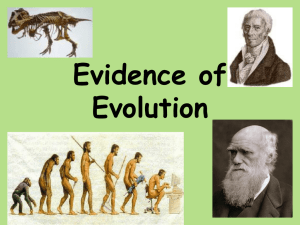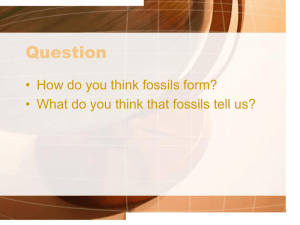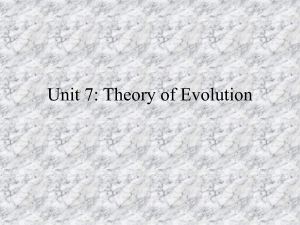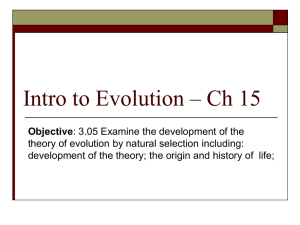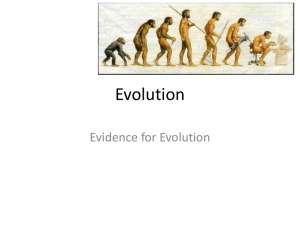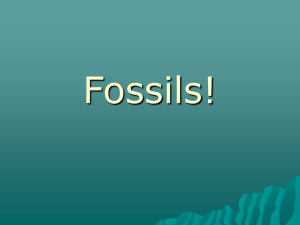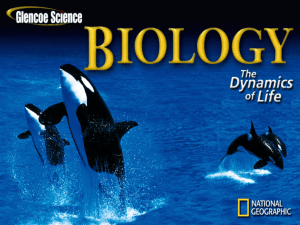Fossils and Evolution ppt - Troup 6
advertisement
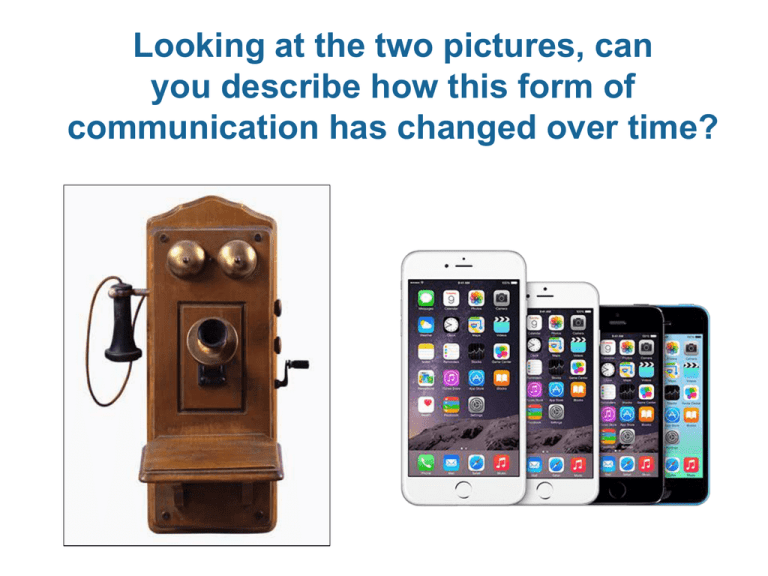
Looking at the two pictures, can you describe how this form of communication has changed over time? Essential Question: How do scientists define and support the theory of evolution? Standards: S7L5a. Explain that physical characteristics of organisms have changed over successive generations (e.g. Darwin’s finches and peppered moths of Manchester) S7L5c. Trace evidence that the fossil record found in sedimentary rock provides evidence for the long history of changing life forms. Describe the evidence scientists use to determine that Earth changes over time. Give an example of how Earth has changed over time. Evidence of life’s history on earth is provided by fossils. Fossils are the remains of organisms preserved in the earth. Fossils can consist of bones, bone fragments, imprints, and preserved remains. Most fossils are found in sedimentary rock. Why? Fossils are primarily found in sedimentary rocks because these rocks form at low temperatures and pressures. Some organisms become fossilized in ice or amber. Scientists observe fossil characteristics and make inferences concerning the life of the organism based on these observations. Once scientists piece the fossil below together, what might they be able to know about the once living organism? How can scientists tell that the first organisms lived in oceans, or that dinosaurs lived on land and that they disappeared 65 million years ago? These questions and others can be addressed by determining the age of fossils. Scientists use relative dating and absolute dating to describe the age of fossils. Older fossils are found in deeper layers of the earth’s sedimentary rock; younger fossils are found in the upper layers of the earth’s sedimentary rock. The fossil record and the geologic time scale provide reference to when and how long organisms have existed on planet Earth. The fossil record is the total number of fossils that have been discovered, as well as the information gained from them. The geologic time scale is a system of chronological measurement that describes the timing and relationships between events that have occurred throughout Earth's history. Turn to an elbow partner and answer the question below. Discuss how to determine the correct answer. With the same elbow partner describe the changes in the fossils you see in each layer and what they tell you about that time period. Turn to a different partner. Compare layer C to layer F in the diagram below. What evidence do these fossils provide of changes on earth? Complete the Using Fossils to Gather Evidence of Once Living Organisms Worksheet Mr. Parr Fossils Song Evolution is the process through which species change over time. Evolution is a scientific theory. A scientific theory is a statement based on observation and experiment. If continued observation and experiment support the statement, it may become widely accepted. Activities to demonstrate Evidence and Theory [see resources] D and T Sentence The Great Fossil Find Activity Xenosmilus Activity Look at the two images below. The image on the left shows the skull of a fossil, the Swift Fox (Vulpes velox), compared to the same view of a modern Kit Fox (Vulpes macrotis). With a partner, identify the similarities. The Swift Fox (on the left) was alive during the Pleistocene Epoch. Find the Pleistocene Epoch on the Geologic Time Scale diagram to the right. If the Swift Fox was alive about 1 million years ago, why is it so similar to the modern Kit Fox? Look at these three organisms. Each fossil comes from a different time on the Geologic Time Scale. Are they similar? How? What can we learn from these two fossil comparisons? Living or once living things share common ancestors and fossils provide evidence for common ancestry. Physical characteristics of organisms change over time and fossils provide evidence of change. Living or once living things share common ancestors and fossils provide evidence for common ancestry. Physical characteristics of organisms change over time and fossils provide evidence of change. Evidence to support the Theory of Evolution… Fossils provide evidence of evolution as the previous slides demonstrated. What other evidence might support evolution? Similarities in Structure and Development provide evidence for the Theory of Evolution. Vestigial Structures are physical structures that were fully developed and functional in an ancestral group of organisms but are reduced and unused in later species. Vestigial Structure Examples In the bodies of whales there are small leg bones The skeletons of snakes also have traces of leg-like structures that are not used Vestigial Structure Examples Vestigial toe in the horse Why Some Humans Are Born With Tails Video Similar Structures with Different Functions Similarities in Development Organisms that appear to be very different as adults are similar during early development. Scientists can also tell how closely organisms are related by comparing their genetic material (DNA). In the previous slides we have identified the following evidence of evolution: Fossils, Similarities in Structure and Development, and DNA. Which of the these three main types of evidence do you think would best help scientists prove the relationships among the organisms? A Cladogram or a Branching Diagram are often used to illustrate common ancestry and evolution. Which organisms have fur and mammary glands? Common Ancestor Which organisms have lungs? Common Ancestor Common Ancestor https://www.youtube.com/watch?v=_C6cqsOf2mI The organisms’ characteristics have changed over time, but they share a common ancestor. Which organism(s) in the branching diagram will have the greatest physical difference from its ancestor? Why? Where is the location of the common ancestor for all of the organisms shown? D. C. B. A. What is meant by the dotted lines and question marks? There are missing pieces in the fossil record. D. C. B. A. With a seat partner, compare and contrast the information Figure 1 will provide to the information Figure 2 will provide. Figure 1 Figure 2 Evidence of Evolution Video: https://www.youtube.com/watch?v =lIEoO5KdPvg Summarizing Strategy: 3 – 2 – 1 Describe three ways in which scientists support the theory of evolution. Identify two ways in which scientists know the physical characteristics of organisms change over time. Describe why the fossil record is important.



